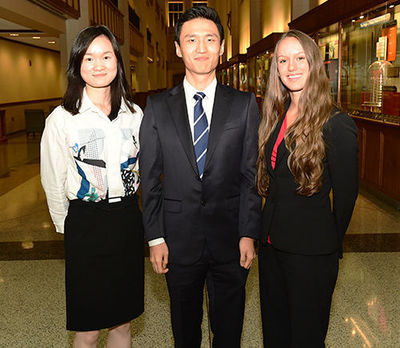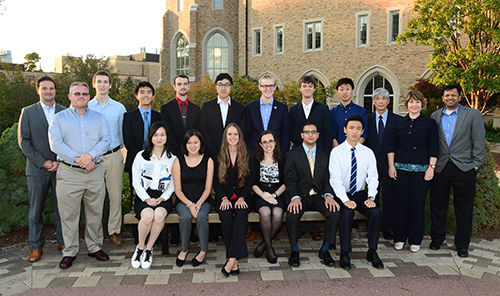Kirstin Schauble, a senior studying electrical and computer engineering at Seattle University, won first place and $3,000 in the sixth annual NDConnect undergraduate research competition held at the University of Notre Dame on October 18.

Jiajia Luo, Jake Song, and Kirstin Schauble
The event – which was sponsored this year by HRL Laboratories, IBM, International Rectifier, Murata Electronics, Nikon Instruments, Raytheon, Serim Research, Texas Instruments, and WITec Instruments and organized by Notre Dame’s Center for Nano Science and Technology (NDnano) – is a national competition that recognizes outstanding undergraduate researchers in nanoscience and nanoengineering. The thirteen finalists were selected from a pool of applicants who submitted a recap of their research at the end of the summer, along with CVs and letters of recommendation from their faculty advisers.
For the competition, the finalists presented short, oral presentations of their research, followed by in-depth explanations to industry judges during a poster session. Winners were selected based on their research accomplishments and the ability to communicate their findings.
The $2,000 second prize and $1,000 third prize were awarded to Jake Song and Jiajia Luo, respectively, who are both seniors studying materials science and engineering at Northwestern University.
Kirstin’s project, titled “Nucleating high-k dielectrics on MoS2 using plasma-enhanced atomic layer deposition (PEALD),” was conducted at Duke University under the direction of Professor Aaron Franklin. Dr. Ram Chelakara (Raytheon) noted that the judges were particularly impressed with Kirstin’s enthusiasm for her work and the large contribution she made to materials processing and characterization through fabricated device measurements. Dr. Chelakara added that Kirstin had very good results, especially given the steep learning curve required for the two-month project.
Jake’s research project, “Nanomechanical characterization of polymer nanocomposites (PNCs),” was conducted under the supervision of Professor Sinan Keten. “Jake did an extremely good job all around and demonstrated a thorough understanding of his material,” said Erik Probstfield (International Rectifier). “His work helps to clarify the physical conditions that affect interphase characterization results.”
Jiajia’s project, “Self-aligned short-channel devices using monolayer MoS2 for high-speed electronics” was advised by Professor Mark Hersam. In discussing her award, Dr. Dane Wheeler (HRL Labs) said the judges were impressed with the breadth of Jiajia’s work, which included a materials effort, along with some novel device fabrication and characterization work. “Her personal interest, ambition, and passion for the work was also a factor in our decision,” he said.
Congratulations to our other 2016 NDConnect finalists!

Standing (left to right): Dane Wheeler (HRL), Erik Probstfield (International Rectifier), Elliot Young, Thomas Yang, Aaron McLeod, Yudong Chen, Matthew Sis, Joseph Burkhart, Andrew Ye, Yuji Nakanishi (Murata), Roxana Nicolaescu (Serim), and Ram Chelakara (Raytheon). Seated: Jiajia Luo, Brittany Trang, Kirstin Schauble, Sophie McClain, Mohamed Kashkoush, and Jake Song. Photos: W. Evard, Notre Dame.
Joseph Burkhart, a senior studying chemistry at St. Olaf College.
Research: "Calculated packing-dependent optical behavior of Au octopods"
Adviser: Prof. Sara Skrabalak (Indiana University)
Yudong Chen, a senior in mechanical engineering at Purdue University.
Research: “Modeling of a roll-to-roll plasma CVD system for graphene"
Adviser: Prof. Timothy Fisher
Mohamed Kashkoush, a senior industrial engineering student at the University of Pittsburgh.
Research: “Silver coated silicon nanocone arrays for enhanced antibacterial surfaces”
Adviser: Prof. Paul Leu
Sophia McClain, a chemistry major in her junior year at Indiana University.
Research: “Synthesis of Pd-Cu nanostructures via seed mediated co-reduction”
Adviser: Prof. Sara Skrabalak
Aaron McLeod, a junior studying chemistry at Temple University.
Research: “Super-resolution imaging of fluorophores bound to silica-coated gold nanorods"
Adviser: Prof. Katherine Willets
Matthew Sis, a senior in chemical engineering at the University of Nebraska.
Research: “Ionic driven embedment of lipid nanoparticles in polymer films for local therapeutic delivery”
Adviser: Prof. Srivatsan Kidambi
Brittany Trang, a senior studying chemistry at Ohio State University.
Research: “Tarnishing silver into semiconductors"
Adviser: Dr. J. Nathan Hohman (Lawrence Berkeley National Laboratory)
Hao Tian (Thomas) Yang, an electrical engineering student in his sophomore year at Northwestern University.
Research: “Quantum dot modeling, growth, and characterization for uncooled, high-performance long-wavelength infrared photodetectors”
Adviser: Prof. Manijeh Razeghi
Andrew Ye, a junior majoring in applied physics and engineering studies at Carnegie Mellon University.
Research: “2D layered heterostructure devices with graphene, hexagonal boron nitride, and phosphorene: Testing for negative differential resistance”
Adviser: Prof. Randall Feenstra
Elliot Young, a senior materials science and engineering student at the University of Illinois.
Research: “Scanning tunneling microscopy and spectroscopy of TaS3 and TiS3”
Adviser: Prof. Joseph Lyding
Summaries of top projects
Kirstin's research demonstrated the viability and benefit of using Plasma Enhanced Atomic Layer Deposition (PEALD) to uniformly deposit ultrathin layers of high-k dielectrics (specifically HfO2 and Al2O3) on 2D MoS2 (a transition metal dichalcogenide), which represents a potential replacement for silicon as silicon reaches its scalability limits. Top-gated field-effect transitors (FETs) were fabricated and characterized and showed that the use of HfO2 PEALD-enabled FETs yielded increased Ion/Ioff, reductions in subthreshold swing and hysteresis, and increased ON-currents. Of significant note, the increased ON-state indicates that the applied PEALD process did not impact the electrical transport in MoS2. Additionally, the thin PEALD dielectric had very low leakage current and yielded a device with 6 orders of magnitude switching in drain current.
Jake used Coarse-Grained Molecular Dynamics nanoindentation simulations to characterize the stiffened polymer ‘interphase’ in polymer nanocomposites, and to understand why local characterization methods such as nanoindentation yield larger interphase readings than global characterization methods such as film wrinkling and molecular simulations. It was determined that nanoindentation-based interphases were artificially large due to an indenter tip size effect, and that removing this artifact yielded an interphase length-scale of just a few nanometers. The work resolves the prevailing controversy in literature surrounding interphase characterization techniques, and establishes the constitutive mechanical behavior of polymer nanocomposites and related nanostructures.
Jiajia's research focuses on investigating and improving the feasibility of using monolayer MoS2 as the building block for high-performance, high-frequency electronics. She pursued a novel fabrication scheme for local gated short-channel MoS2 transistors. Its asymmetric structure led to asymmetric electrical properties, and the device successfully achieved decent current saturation region.